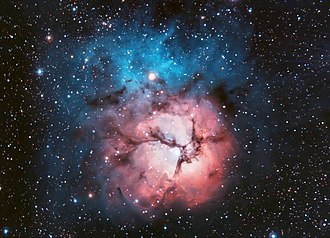A nebula is a cloud of gas and dust in outer space. Nebulae are often referred to as “star nurseries” because they are regions where new stars are formed. These clouds are made up of hydrogen, helium, and other ionized gases, as well as dust particles. The gases in a nebula can be ionized by radiation from nearby stars, causing them to emit light of various colors, including red, blue, and green.
There are many different types of nebulae, including emission nebulae, reflection nebulae, and dark nebulae. Emission nebulae are the most common type, and they emit light due to the ionization of hydrogen gas by radiation from nearby stars. Reflection nebulae, on the other hand, do not emit light but instead reflect the light of nearby stars. Dark nebulae are clouds of gas and dust that are so dense that they block the light of stars behind them.
Each Nebula has their own unique characteristics and properties. Here are some of the most common types of nebulae:
Emission Nebulae: Emission nebulae are clouds of gas that emit light, usually due to the presence of ionized hydrogen. These nebulae are often referred to as “HII regions,” as they contain hydrogen that is ionized by radiation from nearby stars. Emission nebulae are often bright and colorful, with hues of red, blue, and green.
Reflection Nebulae: Reflection nebulae do not emit light themselves, but instead reflect the light of nearby stars. These nebulae are often bluish in color, as they reflect the blue light of nearby stars more efficiently than other colors.
Planetary Nebulae: Planetary nebulae are formed when a star similar in size to our sun runs out of fuel and begins to die. As the star’s outer layers expand and cool, they create a shell of gas and dust that is illuminated by the hot core of the dying star. Planetary nebulae are often spherical or elliptical in shape and can be quite colorful.
Supernova Remnants: When a massive star explodes in a supernova, it creates a supernova remnant, which is a cloud of gas and dust that is expanding outward at high speeds. These remnants can be very complex in shape and are often associated with pulsars, or rapidly rotating neutron stars.
Dark Nebulae: Dark nebulae are clouds of gas and dust that are so dense that they block the light of stars behind them. These nebulae are often visible against a backdrop of bright emission nebulae, as they appear as dark shapes in the sky.
Molecular Clouds: Molecular clouds are large, cold clouds of gas and dust that are primarily composed of molecular hydrogen. These clouds are the birthplaces of new stars and are often the sites of ongoing star formation.
HII Regions: HII regions are regions of ionized hydrogen gas that are typically associated with newly formed stars. These regions are often identified by the presence of bright emission nebulae, which emit light due to the ionization of hydrogen by nearby stars.
These are just a few of the many different types of nebulae that exist in the universe. Each type has its own unique properties and characteristics, and they all play important roles in the processes of star formation and the evolution of galaxies.
What don’t we know about Nebulae?
Despite our advanced knowledge of nebulae, there is still much we don’t know about these fascinating objects in space. Here are some of the things we are still trying to learn:
The exact mechanisms by which stars form within nebulae: While we know that nebulae are the birthplaces of new stars, the precise process by which stars form from the gas and dust within these clouds is still not fully understood.
The composition and structure of nebulae: Although we can identify the main elements and compounds present in nebulae, there is still much we don’t know about the specific distribution of these materials and the way they interact within the nebulae.
The role that nebulae play in galaxy formation and evolution: While we know that nebulae are integral to the formation and evolution of galaxies, the details of how they contribute to these processes are still being studied.
The origins of the different types of nebulae: While we have identified many different types of nebulae, the exact mechanisms that lead to the formation of each type are still not fully understood.
The relationship between nebulae and other objects in the universe: While we know that nebulae are connected to other objects in space, such as stars, galaxies, and black holes, the nature of these relationships is still being explored.
Nebulae are important objects of study for astronomers, as they provide insight into the processes of star formation and the evolution of galaxies. They can also be very beautiful and striking objects to observe, and many nebulae are visible from Earth with telescopes or even with the naked eye.

